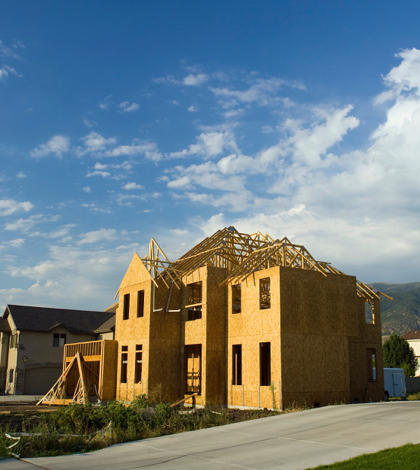And that trend won’t change, according to various water experts. They say the state learned from past droughts and installed conservation measures that are helping it get through the current shortage.
How important is housing construction to California’s economy?
So important that one of the most severe droughts in the state’s history, now in its fourth year, won’t stop it, or even slow it down.
Even with Gov. Jerry Brown mandating a 25 percent reduction in the state’s water use – an order aimed mostly at outdoor water use in residential neighborhoods – no one is suggesting that the state consider slowing down its housing development.
Like the state’s agricultural interests, its housing industry was left largely untouched by the Brown’s severe conservation order, which he issued in April after voluntary measures failed to save enough water.
That’s fine with one local elected official.
“That would be the worst thing we could do,” Hesperia City Councilman Paul Russ said of a possible moratorium on homebuilding. “Yes, the drought is bad, but the state relies too much on building new houses. From an economic standpoint, any slowdown in housing construction would be a catastrophe.”
Russ made his remarks last month at the ninth annual San Bernardino County Water Conference, which was sponsored by the Baldy View Chapter of the Building Industry Association of Southern California.
Russ was part of panel discussion at Cal State San Bernardino on how California should balance its development needs with its dwindling water supply, how a government body should respond to slow-growth advocates who might use the drought to buttress their arguments and, most of all, how to avoid a moratorium on building.
The panel – which included Randall Lewis, executive director of Lewis Operating Corp. in Upland, and Larry Acker, chief executive officer of ACT Inc. in Costa Mesa, which develops systems to deliver potable hot water – found multiple reasons for not only keeping housing construction going but increasing the rate of building, as the state now suffers from a shortage of new single-family homes.
“Even in a water shortage as bad as this one the state needs sustainable growth, and I think Gov. Brown knows that,” said Lewis, whose company develops mixed-use planned communities and residential subdivisions in California and Nevada. “None of the conservation measures he’s put in call for any slowdown in growth.”
But the question remains: Does California have enough water to build more houses and sustain growth? State water experts say yes, but only if residents and businesses continue to conserve water and make some changes to how it builds houses, starting with smaller lots, irrigated water and the use of more drought-resistant landscaping.
The housing industry, which is absolutely crucial to the state’s economy, should be left alone because the houses being built today are much more water-efficient than the houses that were built 20 to 30 years ago, said Carlos Rodriguez, chief executive officer of the BIA’s Bald View chapter.
A single-family home built in California during the 1970s uses about 46,000 more gallons of water per year than a house built today, Rodriguez said.
“The new houses don’t have nearly as much landscaping or sod and a lot of them have drip irrigation,” Rodriguez said. “The fact is that [outdoor landscaping] is much more water-efficient than they used to be. The water-conservation programs that we have in California today are as efficient as any in the nation.”
Any moratorium on housing construction – even a short, temporary slowdown – could be fatal to the state’s economy, according to Rodriguez.
Today, San Bernardino County needs to build about 60,000 homes in order to keep pace with demand, Rodriguez said.
“You have two major problems now in the state, the drought and not enough houses being built,” Rodriguez said. “If you stop building houses you will make that problem worse, and you will still have the drought.”
California should continue to build houses because it needs them and because it has more than enough water to do so, said Joe Grindstaff, general manager of the Inland Empire Utilities Agency, a municipal water agency in Chino Hills that imports water at wholesale prices and also treats wastewater.
“We have more than enough water to continue to grow, and what we’re building is a lot more efficient than it used to be,” said Grindstaff, whose agency serves approximately 830,000 people in western San Bernardino County. “We have some challenges, but we have the most sophisticated conservation system in the world, and we have access to groundwater supplies.”
The state is even looking to the Pacific Ocean to quench its thirst.
Sometime next year, the $1 billion Carlsbad Desalination Plant is expected to open and begin delivering an estimated 50 million gallons of drinking water to San Diego County every day. Fifteen other desalination projects have been proposed from Los Angeles to San Francisco, even though the process is expensive and is opposed by some environmental groups.
“The day is coming when desalination technology will be an option, for solving the state’s water shortage” Grindstaff said.
State water officials learned many lessons from California’s last major drought, which started in 1989 and lasted into 1994, according to Grindstaff.
“A lot of the conservation measures that are in place now happened because of that drought, and we’ve also built a lot of infrastructure since then,” Grindstaff said. “If we hadn’t learned those lessons we might be in a lot worse shape today.”
Most water agencies in California’s urban areas have ample water supplies, having planned for droughts well in advance, said Ellen Hanak, director of the Water Policy Center at the Public Policy Institute of California.
“I’m more concerned about some of the agencies in rural areas, because not all of them have a good conservation plan in place,” Hanak said. “But most of our water agencies have planned for this kind of drought, and it’s paying off.”
The drought’s severity has sparked a much-needed discussion on how to balance development with water needs, said Kirby Brill, general manager of the Apple Valley-based Mojave Water Agency, which serves about 450,000 customers in the High Desert.
“There’s been a good dialogue, and we also have a lot of history to draw on,” said Brill, who said the drought has had no impact on homebuilding in the Victor Valley. “But it was good that we’ve had this discussion. How we responded to this drought was crucial, and we’ve learned some lessons.”
 IE Business Daily Business news for the Inland Empire.
IE Business Daily Business news for the Inland Empire.


